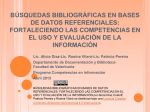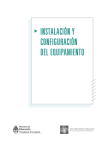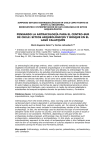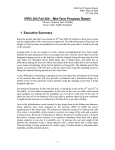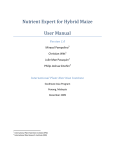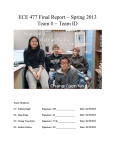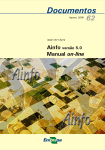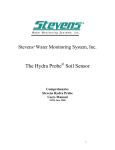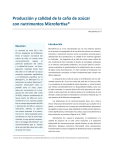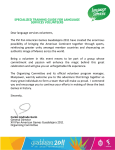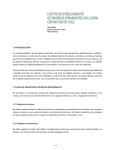Download FONDECYT 2011
Transcript
FONDECYT 2011 INITIATION INTO RESEARCH FUNDING COMPETITION NATIONAL COMMISSION FOR SCIENTIFIC & TECHNOLOGICAL RESEARCH ROUGH DRAFT VERSION 03-05-2011 19:05:12 PRINCIPAL INVESTIGATOR: Juan Hirzel Campos NATIONAL FUND FOR SCIENTIFIC & TECHNOLOGICAL DEVELOPMENT (FONDECYT) Bernarda Morín 551, Providencia - P.O Box 297-V, Santiago 21 Telephone: (56-2) 435 4350 Fax (56-2) 3720828 e-mail: [email protected] SANTIAGO-CHILE FONDECYT STUDY GROUP AGRONOMIA N° FONDECYT NATIONAL RESEARCH FUNDING COMPETITION 2011 INITIATION INTO RESEARCH COMPETITION GENERAL INFORMATION PROPOSAL ID : PROPOSAL TITLE : POTENTIALITY OF MINERALIZABLE NITROGEN IN PADDY RICE SOILS OF CHILE FONDECYT COUNCIL : Science PROPOSED LENGTH : 3 Year(s) PROPOSAL KEYWORDS : paddy rice soil nitrogen mineralization PRIMARY FIELD : Soil Sciences SECONDARY FIELD(S) : Plant Nutrition, Crops Fertilization APPLICATION SECTOR : Soil & Underground Pollution Agriculture & Horticulture APPLICATION REGION(S) : Región del Libertador General Bernardo O'Higgins Región del Maule Región del Bío Bío YOUR PROPOSAL INVOLVES STUDY/STUDIES ON/WITH Required Documents One or more of the following: Clinical studies in human beings (use of samples and/or biological material) Fully explanatory and detailed Approval certificate from the Institution Ethics Committee, Permission from the institutional responsible officer, Informed Consent (subjects over 18 years of age), Informed Consent (subjects less than 18 years of age) With persons (interviews, surveys, focus groups, other) In/With animals, obtaining and/or using animal samples and/or biological material Fully explanatory and detailed Approval certificate from the institution Bioethics Committee based on the “3Rs” principle, Animals Handling Protocol (techniques, supervision and other) In/with hazardous materials(pathogenic agents, recombinant DNA and/or radioisotopes, waste, other) Approval certificate from the institution Biosafety Committee Other Certificates and Permissions Approval document from the Council of National Monuments, Certificates from the SAG (Agricultural and Livestock Service), CONAF (National Forestry Corporation), Sernapesca (National Fishing Service), SNASPE (National System of State-protected Wilderness Areas), Access to archives and/or databases, etc. Does not apply Not Applicable REQUIRED DOCUMENTS X Please let us know if all permissions/ Approval certificate required are attach to the proposal?* NO FUNDING REQUEST SUMMARY (1000CLP $) BUDGET ITEMS Annual Amounts (1000 CLP$) YEAR 1 YEAR 2 YEAR 3 Total Staff 4.140 5.160 4.640 13.940 Travel 1.000 1.600 3.000 5.600 0 0 0 0 8.884 17.980 17.360 44.224 10.880 0 0 10.880 24.904 24.740 25.000 74.644 International Cooperation Travel Operational Expenses Equipment Annual Total (1000CLP $) SPONSORING INSTITUTIONS INST.DE INVESTIGACIONES AGROPECUARIAS ADDITIONAL FUNDING COMMITTED FROM OTHER INSTITUTIONS/SOURCES INSTITUTION Amount (1000 CLP$) TOTAL 0 PRINCIPAL INVESTIGATOR NAME : Juan Hirzel Campos E-MAIL : [email protected] INSTITUTION : INST.DE INVESTIGACIONES AGROPECUARIAS PROPOSAL ABSTRACT: Rice, Oryza sativa L., is very important in the diet of the world’s population because of its nutritional value. The total world area cultivated with rice in the last decade was approximately 147.5 million hectares of which 23 900 ha were in Chile. The world’s paddy rice soils belong to five taxonomic orders: Entisols, Inceptisols, Alfisols, Vertisols, and Ultisols. However, in Chile the principal taxonomic orders being cropped are Inceptisols, Alfisols, and Vertisols located between 34 and 36° south latitude. Rice crop production depends on several factors such as climate, soil physical condition, soil chemical fertility, water management, sowing date, cultivar, seed dose, weed control, and fertilization with nitrogen as the main nutrient associated with yield. Since mineralization can contribute substantially to plant available N, biological or chemical estimation methods are necessary. Anaerobic incubation is a good method to estimate potentially mineralized N because available N determined by routine methods is low and, in flooded soil conditions, continuous mineralization available to the rice crop, whose magnitude depends on the labile organic N pool, showed a good correlation with crop N-uptake. With regard to soil type, as the chemical environment of submerged soils affects the quality of organic matter, especially the proportion of organic N fractions and chemical structure of specific soil organic matter pools contributing to N mineralization, taxonomic order could affect soil N mineralization ability, element also influenced by N-fertilization. Consequently, to optimize N-fertilizer use in Chile’s rice crop, a study of mineralizable N potential is necessary in paddy rice soil with different N-rates and results must be related to crop N extraction in field conditions. In addition, mineralized N will be related to reducible Fe, total N, organic C, and microbial biomass by using simple or multiple correlation analysis. The ratio indices obtained will predict relationships between N-extraction results in field conditions and N-NH4+ mineralized by anaerobic incubation methods, thus helping to estimate Nsupply potential in different rice paddy soils, as well as the need for nitrogen fertilization in these soils prior to crop establishment. To carry out the proposed study, we will use anaerobic incubation for 7 days at 40°C with constant shaking, and anaerobic incubation for 7, 14, 21, and 28 days at 20 and 40°C without shaking. Soils represent the main paddy rice soils of Chile, which include Inceptisols, Alfisols, and Vertisols located between 34 and 36° south latitude. The study period will be three years and will include two experimental cycles under field conditions and incubations under laboratory conditions, as well as outreach and scientific activities, and article preparation for publishing in an international journal. The cost of the project will be MM$ 74.6. Ying, J. S. Peng, G. Yang, N. Zhou, R. Visperas, K. Cassman. 1998. Comparison of high-yield rice in tropical and subtropical environments – II. Nitrogen accumulation and utilization efficiency. Field Crops Research 57:85-93. ODEPA. 2008. Cultivos anuales: superficie, producción y rendimientos. Consulta online en: http://www.odepa.gob.cl/odepaweb/servlet/contenidos.ServletDetallesScr?idcla=12&idcat =2&idn=1736 Olk, D.C., and N. Senesi. 1999. Properties of chemically extracted soil organic matter in intensively cropped lowland rice soil. In: Kirk and Olk (editors). Carbon and nitrogen dynamics in flooded soils. Proceedings of a Workshop, 19-22 April 1999. Los Baños Laguna, Philippines. 188 p. Olk, D.C., C. van Kessel, and K.F. Bronson. 1999. Managing soil organic matter in rice and nonrice soils: agronomic questions. In: Kirk and Olk (editors). Carbon and nitrogen dynamics in flooded soils. Proceedings of a Workshop, 19-22 April 1999. Los Baños Laguna, Philippines. 188 p. Ortega, R. 2007. Analysis of factors affecting spikelet sterility in flooded rice under field conditions in Chile. Archives of Agronomy and Soil Science 53:183-192. Peng, S. R. Buresh, J. Huang, J. Yang, Y. Zou, X. Zhong, G. Wang, and F. Zhang. 2006. Strategies for overcoming low agronomic nitrogen use efficiency in irrigated rice systems in China. Field Crops Research 96:37-47. Reichardt, W., K. Inubushi, and J. Tiedje. 1999. Microbial processes in C and N dynamics. In: Kirk and Olk (editors). Carbon and nitrogen dynamics in flooded soils. Proceedings of a Workshop, 19-22 April 1999. Los Baños Laguna, Philippines. 188 p. Rodrigues, A., W. Hoogmoed, and L. Brussaard. 2008. Soil quality assessment in rice production systems: establishing a minimum data set. J. Environ. Qual. 37:623-630. Rojas, C., R., Alvarado. 1982. Fertilización nitrogenada y fosfatada en arroz en la región centrosur de Chile. Efecto sobre los rendimientos en grano. Agric. Técnica (Chile) 42 (2): 15 - 22. Sahrawat, K. 1983. Nitrogen availability indexes for submerged rice soils. Advances in Agronomy 36:415-451. Sahrawat, K.L., and L.T. Narteh. 2001. Organic matter and reducible iron control of ammonium production in submerged soils. Com. Soil Sci. Plant Anal. 32:1543-1550. Sahrawat, K.L., and L.T. Narteh. 2003. A Chemical index for predicting ammonium production in submerged rice soils. Com. Soil Sci. Plant Anal. 34:1013-1021. Sahrawat, K. 2006. Organic matter and mineralizable nitrogen relationships in wetland rice soils. Commun. Soil Sci. Plant Anal. 37:787-796. Sainz, H.R., H.E. Echeverría, and P.A. Barbieri. 2004. Nitrogen balance as affected by application time and nitrogen fertilizer rate in irrigated no-tillage maize. Agron. J. 96(6):1622-1631. Sainz, H., P. Calviño, H. Echeverría, P. Barbieri, and M. Redolatti. 2008. Contribution od anaerobically mineralized nitrogen to the reliability of planting or presidedress soil nitrogen test in maize. Agron. J. 100(4):1020-1025. Scott, D., A.McLarren, and J. Burger. 2005. Rapid indices of potential nitrogen mineralization for intensively managed hardwood plantations. Commun. Soil Sci. Plant Anal. 36:1421-1434. Soon, Y., A. Haq, and M. Arshad. 2007. Sensitivity of nitrogen mineralization indicators to crop and soil management. Commun. Soil Sci. Plant Anal. 38:2029-2043. Standford, G., and S.J. Smith. 1978. Oxidative release of potentially mineralizable soil nitrogen by acid permanganate extractions. Soil Science 126:210-218. Tang, Q., S. Peng, R.J. Buresh, Y. Zou, N.P. Castilla, T.W. Mew, and X. Zhong. 2007. Rice varietal difference in sheath blight development and its association with yield loss at different levels of N fertilization. Field Crops Research 102:219-227. USDA. 1994. Reference to Soil Taxonomy. USDA, Washington, D.C. Waring, S.A., and J.M. Bremner. 1964. Ammonium production in soil under water-logged conditions as an index of nitrogen availability. Nature 202:951-952. Wienhold, B. 2007. Comparison of laboratory methods and an in situ method for estimating nitrogen mineralization in a irrigated silt-loam soil. Commun. Soil Sci. Plant Anal. 38:17211732. Wilson. C.E., R.J. Norman, and B.R. Wells. 1994a. Chemical estimation of nitrogen mineralization in paddy rice soils: I. Comparison to laboratory indices. Commun. Soil Sci. Plant Anal. 25(5&6):573-590. Wilson. C.E., R.J. Norman, B.R. Wells, and M.D. Correll. 1994b. Chemical estimation of nitrogen mineralization in paddy rice soils: II. Comparison to greenhouse availability indices. Commun. Soil Sci. Plant Anal. 25(5&6):591-604. Wit, C., A. Dobermann, S. Abdulrachman, H. Gines, G. Wang, R. Nagarajan, S. Satawatananont, T. Son, P. Tan, L. Tiem, G. Simbahan, D. Olk. 1999. Internal nutrient efficiencies of irrigated lowland rice in tropical and subtropical Asia. Field Crops Research 63:113-138. where 8.8632 + 30.186 (NAN1) = relationship between available soil N and grain yield (mg Mg-1), and 0.4261 + 24.8 (NAN2) = relationship between N uptake and available soil N (kg mg-1). Equation 2: Quella soil (Vertisol) (Hirzel et al., 2011). N rate (kg ha-1) = [Yield expected (Mg ha-1) * 5.0346 - 16.399] * 1.1574 + 22.625 where 5.0346 - 16.399 (NAN1) = relationship between available soil N and grain yield (mg Mg-1), and 1.1574 + 22.625 (NAN2) = relationship between N uptake and available soil N (kg mg-1). REFERENCES Alvarado, J.R., S. Hernaiz. 2007. Antecedentes generales sobre el arroz en Chile. P. 7. 20. En Alvarado (Ed) Arroz manejo tecnológico. Chillán Chile. Instituto de Investigaciones Agropecuarias. Boletín INIA Nº 162, 180p. Angus, J.F., M. Ohnishi, T. Horie, and L. Williams. 1994. A preliminary study to predict net nitrogen mineralization in a flooded rice soil using anaerobic incubation. Australian Journal of Exp. Agric. 34:995-999. Artacho, P., C. Bonomelli, and F. Meza. 2009. Nitrogen application in irrigated rice growth in Mediterranean conditions: Effects on grain yield, dry matter production, nitrogen uptake, and nitrogen use efficiency. J. Plant Nut. 32(9):1574-1593. Bouman, B.A.M., E. Humphreys, T.P. Tuong, R. Barker, and L.S. Donald. 2007. Rice and water. Advances in Agronomy. Academic Press. 187-237. Bushong, J.T., R.J. Norman, W.J. Ross, N.A. Slaton, C.E. Wilson, and E.E. Gbur. 2007. Evaluation of several indices of potentially mineralizable soil nitrogen. Com. Soil. Sci. Plant Anal. 38:2799-2813. Centro de Información de Recursos Naturales (CIREN). 1983. Descripciones de suelos. Estudio Agrológico Complementario Semi-Detallado VII Región. De-Xi, L., F. Xiao-Hui, H. FENA, Z. Hong-Tao and L. Jia-Fa. 2007. Ammonia volatilization and nitrogen utilization efficiency in response to urea application in rice fields of the Taihu lake region, China. Pedosphere 15(5):639-645. FAO. 2004. Estimaciones globales de las emisiones gaseosas de NH3, NO y N2O provenientes de las tierras agrícolas. Roma: FAO, p: 1-22. ftp://ftp.fao.org/docrep/fao/009/y2780s/y2780s00.pdf Hirzel, J., K. Cordero, C. Fernández, J. Acuña, M. Sandoval, and E. Zagal. 2011. Soil potentially mineralizable nitrogen and its relation to rice production and nitrogen needs in two paddy rice soils of Chile. J. Plant Nut (Japan). Accepted. Hossain, M. S. White, S. Elahi, N. Sultana, M. Choudhury, Q. Alam, J. Rother, and J. Gaunt. 2005. The efficiency of nitrogen fertiliser for rice in Bangladeshi farmers’ fields. Field Crops Research 93:94-107. Huang, J., F. He, K. Cui, R. Buresh, B. Xu, W. Gong, and S. Peng. 2008. Determination of optimal nitrogen rate for rice varieties using a chlorophyll meter. Field Crops Research 105:70-80. Jensen, L.S., I.S. Pedersen, T.B. Hansen, N.E. Nielsen. 2000. Turnover and fate of 15N-labelled cattle slurry ammonium-N applied in the autumn to winter wheat. Europ. J. Agronomy 12(1):23-35. Jing, Q., B. Bouman, H. van Keulen, H. Hengsdijk, W. Cao, and T. Dai. 2008. Disentangling the effect of environmental factors on yield and nitrogen uptake of irrigated rice in Asia. Agricultural System 98(3):177-188. Jokela, W.E., and G.W. Randall. 1997. Fate of fertilizer nitrogen as affected by time and rate of application on maize. Soil Sci. Soc. Am. J. 61:1695-1703. Juliano, B. O. 1993. Rice in human nutrition. Food and Nutrition Series, No 26. FAO, Rome. International Rice Research Institute. Los Baños, Laguna, Philippines. López, B.L. 1991. Cultivos Herbáceos vol. 1 Cereales. Ediciones Mundi-Prensa. Castelló, Madrid, España. 539 p. 60 T1 T2 T3 R2 = 0.9257 40 R2 = 0.8695 30 + -1 N-NH4 (mg kg ) 50 20 R2 = 0.922 10 0 0 7 14 21 28 Incubation time (days) Figure 3. Evolution of N ammonium concentration in a Vertisol in central-south Chile (Hirzel et al., 2011). T1: control without fertilization; T2: 80 kg N ha-1 (22.6 mg kg-1); T3: 160 kg N ha-1 (45.2 mg kg-1). T1 70 T2 Inorganic N (mg kg-1) 60 R2 = 0.9751 T3 50 R2 = 0.9415 40 30 R2 = 0.991 20 10 0 0 7 14 21 28 Incubation time (days) Figure 4. Evolution of inorganic N concentration (ammonium + nitrate) in a Vertisol in central-south Chile (Hirzel et al., 2011). T1: control without fertilization; T2: 80 kg N ha-1 (22.6 mg kg-1); T3: 160 kg N ha-1 (45.2 mg kg-1). Equation 1: Quilmen soil (Inceptisol) (Hirzel et al., 2011). N rate (kg ha-1) = [Yield expected (Mg ha-1) * 8.8632 + 30.186] * 0.4261 + 24.8 T1 140 T2 R2 = 0.9894 T3 120 R2 = 0.9587 N-NH4+ (mg kg-1) 100 R2 = 0.9875 80 60 40 20 0 0 7 14 21 28 Incubation time (days) Figure 1. Evolution of N ammonium concentration in an Inceptisol in central-south Chile (Hirzel et al., 2011). T1: control without fertilization; T2: 80 kg N ha-1 (24.4 mg kg-1); T3: 160 kg N ha-1 (48.8 mg kg-1). T1 T2 140 R2 = 0.9633 T3 120 Inorganic N (mg kg-1) R2 = 0.9844 100 R2 = 0.9928 80 60 40 20 0 0 7 14 21 28 Incubation time (days) Figure 2. Evolution of inorganic N concentration (ammonium + nitrate) in an Inceptisol in central-south Chile (Hirzel et al., 2011). T1: control without fertilization; T2: 80 kg N ha-1 (24.4 mg kg-1); T3: 160 kg N ha-1 (48.8 mg kg-1). continuous shaking) and 28-day anaerobic incubation at 40ºC (without shaking) at N-rates of 0, 80, and 160 kg ha-1 according to the indications of previous studies conducted in Chile (Artacho et al., 2009; Ortega, 2007). Furthermore, phosphorous and potassium were added prior to the abovementioned experiments. Mineralized N on day 7 was similar with and without shaking (data not shown) in both soils. Furthermore, these results indicate that N fertilization stimulates higher soil N mineralization in both evaluated soils with differences in the quantity of mineralized N (Figs. 1, 2, 3, and 4), circumstances not frequently reported in the literature for anaerobic incubation conditions. Consequently, to optimize N-fertilizer in Chile’s rice crop, a study is necessary to determine the potential of mineralizable N in the main paddy rice soils with different N-rates and nutritional adequacy conditions for other nutrients; these results, reported by Hirzel et al. (2011) in two paddy rice soils (equations 1 and 2), must then be related to crop N extraction and productivity in field conditions. Furthermore, it is necessary to take into account that the rice varieties used in Chile are different from those used elsewhere in the world; being variety-specific, the effect of N fertilization (Tang et al., 2007) makes it difficult to apply international results to Chile’s rice crop. Huang et al. (2008) indicated that most studies to improve fertilizer-N management in China were conducted with only one variety, and this limited N management optimization in other varieties. Apart from the classical method of anaerobic incubation proposed by Waring and Bremner (1964), an incubation for 7, 14, 21, and 28 days at 40ºC without shaking will be used since shorter incubation times generally measure the contribution of microbial biomass and soluble N sources, whereas longer incubations can measure the whole active fraction (Scott et al., 2005). Texture, organic C, total N, microbial biomass, and reducible Fe will also be determined and related to mineralizable N obtained in the abovementioned incubation, as pointed out by Sahrawat (2006). Soils will be the main paddy rice soils in Chile, Inceptisols, Alfisols, and Vertisols located between 34 and 36° south latitude. In accordance with the abovementioned features, the proposed study will allow us to characterize and differentiate soil N-supplying capacity of the main paddy rice soils in Chile with N fertilization, along with obtaining a relationship index between capacity and nitrogen fertilization needs in rice crops. Moreover, the Diamante-INIA variety most used Chile, will be employed in this study. The ratio index will allow us to predict relationships between N-extraction in field conditions and NNH4+ mineralized with anaerobic incubation methods in nitrogen fertilization conditions, and consistently estimate the N-supply potential of different paddy rice soils and N-rates before rice crop establishment. Using N-rates adjusted to the crop’s integral needs (N supply capacity of each soil with N fertilization and crop production potentiality) decreases the risk of contaminating surface and groundwater, gaseous N emissions, as well as energy use. incubations can measure the whole active fraction (Scott et al., 2005). Moreover, field experiments carried out in Chile indicate that soil N-supply in paddy rice soil is higher than that obtained by a short anaerobic incubation time (Hirzel et al., 2011). There are alternative chemical methods to anaerobic incubation such as mild oxidation with, for example, KMnO4, K2Cr2O7, oxalic acid (Wilson et al., 1994), KMnO4, and H2SO4 (Bushong et al., 2007; Standford and Smith, 1978). Mild oxidation is significantly related to biological methods by approximating the chemical method’s reliability to predict N mineralization potential. Besides, chemical methods include different extractant:soil ratios. Wilson et al. (1994a) suggested that “acidified K2Cr2O7 of extracted suspension supernatant obtained after centrifugation, regardless of extractant:soil ratio (5:1 to 1:1), predicted potentially mineralizable N as determined by anaerobic incubation”. On the other hand, Saharawat and Nareth (2001 and 2003) indicated that mineralizable N under anaerobic incubation is controlled by organic matter and reducible iron. Different paddy rice soils (Alfisols, Inceptisols, and Vertisols) generate differences in mineralized N-NH4+ with anaerobic incubation at 40ºC for 14 days or acid oxidation (Bushong et al., 2007) with unknown rates and quantities, especially in Chile’s paddy rice soil. Since organic matter is an important nitrogen source for N-supply in paddy rice soil, quantity is very important (Olk et al., 1999). Reichardt et al. (1999) indicate that the formation and remineralization of soil organic matter depend on C and N biogeochemical pathways that are governed by soil microbial biomass and soil enzymes, fact which strengthens the initiative of this research proposal to work with soil incubations. These authors also indicate that the microbial biomass pool sizes in rice soils account for only 2 to 4% of total C, but that this fraction is the most labile of soil organic matter. In addition, the chemical environment of flooded soils affects the organic matter quality, especially the proportion of organic N fractions and chemical structure of specific soil organic matter pools that contribute to N mineralization (Sahrawat, 2006). Olk and Senesi (1999) point out that soil organic matter appears to play a significant role in crop nutrient uptake in intensively cropped lowland rice soils, but process-level knowledge is insufficient about how submerged conditions of this unique cropping system affect soil organic matter, and possibly nutrient cycling and crop uptake. Furthermore, functions of N-immobilizing and remobilizing of soil biota are influenced by organic C and fertilizer inputs, as well as controlling redox potential via water management (Reichardt et al., 1999), which can affect N-supply in the soil and rice crop yield, thus affecting rice crop response to N applied as fertilizer. These effects are also observed when determining N use efficiency (yield per unit of total N uptake) as indicated by some authors (Hossain et al., 2005; Peng et al., 2006; Witt et al., 1999; Ying et al., 1998) who observed values between 23 and 121 kg grain kg-1 of applied N . Soil N supply plays an important role in N nutrition of wetland rice because half to two-thirds of total N taken up by rice crops, even in N fertilized paddies, comes from the soil N pool (Sahrawat, 1983). This type of information is unavailable in Chile, thus generating problems in both N-rate optimization and rice crop productivity; therefore, studies to assess soil N-supply capacity in Chile’s paddy rice soil must be conducted. A preliminary study in two soils (Inceptisol and Vertisol) located in central-south Chile shows differences in mineralized N-NH4+ (Figs. 1, 2, 3, and 4) (Hirzel et al., 2011). In these experiments, 7-day anaerobic incubation was at 40ºC (with PROPOSAL DESCRIPTION, THEORETICAL BACKGROUND AND LITERATURE REVIEW: Rice, Oryza sativa L., is very important in the diet of the world’s population because of its nutritional value (Juliano, 1993) and low price. In the last decade, the world area cultivated with rice was approximately 147.5 million ha (FAO, 1993) with Asia having the highest cultivated area (Bouman et al. 2007; Jing et al., 2008). In Chile, 23 900 ha are cultivated with rice (ODEPA, 2007), a 40%decrease in the last two decades (Rojas and Alvarado, 1982). Cultivated paddy rice soils worldwide belong to five taxonomic orders: Entisols, Inceptisols, Alfisols, Vertisols, and Ultisols (López, 1991; USDA, 1994). However, the main taxonomic orders in Chile are Inceptisols, Alfisols, and Vertisols (CIREN, 1983) located between 34 and 36º south latitude (Alvarado and Hernaiz, 2007). Rice production depends on several factors such as climate, soil physical condition, soil chemical fertility, water management, sowing date, cultivar, seed dosage, weed control, and fertilization (Angus et al., 1994). Nitrogen (N) is the main nutrient associated with yield in fertilization (Angus et al., 1994; Bouman et al., 2007; De-Xi et al., 2007; Jing et al., 2008; Sahrawat, 2006; Wilson et al., 1994). In this regard, field studies in Chile using increasing N rates in rice crops have indicated that the incorrect use of N-rates to generate alterations in the crop cycle affects the length of the vegetative and reproductive cycles, as well as crop productivity. For example, when the rice crop receives a high N-supply, the vegetative cycle is longer and the reproductive cycle is reduced, thus decreasing yield (Hirzel et al. 2011). To optimize N-fertilizer supply in young crops, knowledge of the amount of N supplied by mineralization (Angus et al., 1994; Sainz et al., 2008) is necessary since crop N uptake derives mainly from soil reserves (organic matter mineralization, microbial biomass turnover, N-NH4+ fixed in clay) (Jokela and Randall, 1997; Jensen et al., 2000; Sainz et al., 2004; Sahrawat, 2006), and N fertilization (Wienhold, 2007). Furthermore, a small fraction is derived from irrigation water and other environmental and biotic sources. Soil N supply or quantity of available mineral N for plant uptake over time is highly dynamic, difficult to estimate, and represents only a very small fraction of total soil N (Scott et al., 2005; Wienhold, 2007). Since mineralization can substantially contribute to plant-available N, biological or chemical estimation methods are necessary (Angus et al., 1994; Bushong et al., 2007; Soon et al., 2007). Several authors have proven that anaerobic incubation is a good method for assessing potentially mineralized N because initial soil N is scarce, and in flooded soil, continuous N supply to the rice crop depends on mineralized ammonium from labile organic N (Angus et al., 1994; Bushong et al., 2007; Rodriguez et al., 2008; Soon et al., 2007; Wilson et al., 1994a). This incubation method is also a good indicator of mineralizable N in other crops such as corn, which was reported by Sainz et al. (2008) in 26 site-years in southeastern Argentina. In addition, Angus et al. (1994) suggested that mineralization measurements in flooded soil during rice growing were a very good indicator of crop N-uptake. Anaerobic incubation time and temperature have already been discussed (Angus et al., 1994; Bushong et al., 2007; Wilson et al., 1994a). Thus, 7 days at 40ºC (shorter incubation time) generally measures the contribution of microbial biomass and soluble N sources, whereas long HYPOTHESES: State your working hypotheses or research questions that will guide your research. Make sure your hypotheses or research question(s) are grounded on the theoretical-conceptual background of your proposal. The maximum length for this section is ½ page. (Use Verdana font size 10). <Begin to write here> 1. Under flood conditions, different soil types for the rice crop show differences in nitrogen supply potential, which could increase if nitrogen fertilization is applied. 2. An index will be calculated, which relates both rice crop yield and nitrogen uptake in field conditions with the nitrogen supply capacity of soil in nitrogen fertilization conditions determined in laboratory conditions. This will allow farmers to optimize nitrogen rate use for each soil condition and yield potential before crop establishment. GOALS: Specify your general and specific goals. The maximum length for this section is ½ page. (Use Verdana font size 10). <Begin to write here> General goal: To optimize nitrogen use in rice crops for different soil types in order to obtain an appropriate yield and decrease the risk of environmental pollution. Specifics goals: 1. To determine nitrogen supply potential from the soil reserve under anaerobic conditions in the main paddy rice soils in Chile (Inceptisols, Alfisols, and Vertisols) at different nitrogen fertilization levels under laboratory conditions. 2. To obtain an index for the main paddy rice soils in Chile (Inceptisols, Alfisols, and Vertisols), which relates both rice crop yield and nitrogen uptake to nitrogen fertilization, and depends on soil nitrogen supply determined in laboratory conditions. 3. To generate information that optimizes nitrogen rates for the rice crop using an index that relates different crop yield levels and nitrogen supply capacity in fertilization conditions in the main paddy rice soils in Chile. Wilson. C.E., R.J. Norman, B.R. Wells, and M.D. Correll. 1994b. Chemical estimation of nitrogen mineralization in paddy rice soils: II. Comparison to greenhouse availability indices. Commun. Soil Sci. Plant Anal. 25(5&6):591-604. split plot will be the N rates used (0, 80, and 160 kg ha-1). Incubation time and temperature will be the same for both treatments (with and without shaking) at 40ºC and for a 7-day incubation according to Waring and Bremner (1964). At the same time, for the 28-day soil incubation without shaking at two temperatures (20 and 40ºC) and three N rates (0, 80, and 160 kg ha-1), a split-split-split plot will be used where the main plot will be the soils (six locations), the split plot the incubation temperature, the split-split plot incubation time (0, 7, 14, 21, and 28 days), and the split-split-split plot the N-rates. Both experiments will consist of four replicates per treatment. The field experiment design is a split-split plot design where the main plot will be the evaluation year (two years), the split plot the location (six locations), and the split-split plot the N-rates (0, 80, and 160 kg ha-1). We will use four replicates per treatment in this experiment. Potential N mineralization and the rate constant will be determined by the non-linear GaussNewton method (Bonde et al., 1988). Results will be examined by ANOVA and the least significant difference (LSD) test (P = 0.05) using the SAS general model procedure (SAS Institute, 1989). To determine the relationships between mineralized N and the parameters of grain yield, N, P, and K uptake by the crop, a linear mathematical model will be used with the SAS procedure simple regression. At the same time, a simple or multiple correlation analysis (SAS Institute, 1989) will determine the relationships between mineralized N and the reducible Fe, total N, organic C, and microbial biomass parameters. Finally, the ratio index between yield and nitrogen uptake (kg N ton grain-1) and N apparent recovery efficiency (NARE) will allow us to adjust N-rates for commercial crops in accordance with soil N supply potentiality (Hirzel et al., 2011). REFERENCES Bonde T, J. Schnürer, and T. Rosswall. 1988. Microbial biomass as a fraction of potentially mineralizable nitrogen in soils from long-term field experiments. Soil Biol Biochem 20(4):447-452. Hirzel, J., K. Cordero, C. Fernández, J. Acuña, M. Sandoval, and E. Zagal. 2011. Soil potentially mineralizable nitrogen and its relation to rice production and nitrogen needs in two paddy rice soils of Chile. J. Plant Nut (Japan). Accepted. Mulnavey, L.R. 1996. Nitrogen Inorganic forms. P. 1123 – 1184. In: J.M. Bartels (ed) Methods of Soil Analysis part 3 Chemical Methods. American Society of Agronomy inc. Publisher. Madison, Wisconsin, USA. Rees, R., and Castle, K., 2002. Nitrogen recovery in soils amended with organic manures combined with inorganic fertilisers. Agronomie 22:739-746. Sadsawka, A., M.A. Carrasco, R. Grez, M. Mora, H. Flores, A. Neaman. 2006. Métodos de análisis recomendados para los suelos de Chile. Serie Actas INIA Nº 34. 164 p. Sahrawat, K.L., and L.T. Narteh. 2001. Organic matter and reducible iron control of ammonium production in submerged soils. Commun. Soil Sci. Plant Anal. 32:1543-1550. Sahrawat, K. 2006. Organic matter and mineralizable nitrogen relationships in wetland rice soils. Commun. Soil Sci. Plant Anal. 37:787-796. SAS Institute. 1989. Usage and Reference. Version 6. 501 p. SAS Institute Inc., Cary, North Carolina, USA. Scott, D., A.McLarren, and J. Burger. 2005. Rapid indices of potential nitrogen mineralization for intensively managed hardwood plantations. Commun. Soil Sci. Plant Anal. 36:1421-1434. Waring, S.A., and J.M. Bremner. 1964. Ammonium production in soil under water-logged conditions as an index of nitrogen availability. Nature 202:951-952. be determined by adding 12.5 mL 2M KCl, the mixture shaken for 1 hr (Mulnavey, 1996), filtered, and N-NH4+ determined with a Skalar auto-analyzer. Potential N mineralization will be calculated by using results from both anaerobic incubation methods. Cumulative mineralized N will be represented mathematically by a first order equation (Scott et al., 2005): Nt = No [1-e(-kt) ] where Nt is cumulative organic N mineralized at any specific time (mg kg-1); No is potentially mineralizable N; k is rate constant (wk-1); and t is incubation time (wk). All field experiment plots will be cultivated under traditional management to optimize crop growth in accordance with standard agronomic practices for rice crops in central Chile. All treatments will be fertilized by hand on the day prior to sowing with 60 kg ha-1 each of P2O5 and K2O as triple super phosphate and potassium chloride. N (urea) will be applied three times: 33% the day prior to sowing, 33% in tillering, and 34% in initial panicle. The seed will be pre-germinated two days before sowing. After emergence, weed control will consist of a combination of herbicides with Quinclorac (Facet 25 SC 250 g L-1), MCPA (MCPA 750 SL 750 g L-1), and Bentazon (Basagran 480 g L-1) at rates of 0.45, 0.19, and 0.72 kg a.i. ha-1. Seed dose will be 140 kg ha-1 in all experimental locations. The Diamante-INIA cultivar (main variety used in Chile) will be used in the experiments. The crop will be harvested at grain maturity (with 20% grain humidity). Grain moisture content will be measured with a Satake model SS-5 moisture meter. Grain yield, wholeplant dry matter, nitrogen, phosphorus, and potassium concentrations will be determined with samples collected at harvest time. Dried subsamples will be ground in a mill, put through a 2 mm sieve, and analyzed. Total N will be determined by the macro-Kjeldahl procedure, and total K by atomic emission spectrophotometry after dry ashing at 500°C and acid digestion (2M HCl). P will be measured in the same extracts by colorimetry following the molybdate ascorbic acid method. Moreover, to estimate crop N uptake capacity, N apparent recovery efficiency (NARE) will be calculated as the difference between the total N uptake of each fertilizer treatment and control divided by total applied N (Rees and Castle, 2002): NARE = (A – B) / C where A = N uptake in treatment (kg ha-1); B = N uptake in control (kg ha-1); and C = N applied in treatment (kg ha-1). In addition, the relationships between mineralized N in incubations without shaking for 7, 14, 21, and 28 days at two temperatures and N uptake by the crop will be determined for each soil and evaluated with a linear mathematical model (Wilson et al., 1994; Sahrawat, 2006; Hirzel et al., 2011). The same procedure will be used to determine the relationship of P and K uptake and mineralized N. On the other hand, this mineralized N will also be related to reducible Fe, total N, organic C, and microbial biomass using simple or multiple correlation analysis (Sahrawat and Narteh, 2001; Sahrawat, 2006). Experimental design For soil incubation experiments in controlled laboratory conditions, the shaking effect and N rates will be evaluated in a split-split plot design where the main plot will be either with or without shaking treatment, the split plot will be the evaluated soils (six locations each year), and the split- METHODOLOGY: The main rice paddy soils of Chile, which include Inceptisols, Alfisols, and Vertisols located between 34 and 36º south latitude, will be sampled in this study with two locations for each soil type (total of six locations). Soil samples will be collected in cores of 0 to 20 cm before crop establishment, physically and chemically characterized, subsequently fertilized with N rates, and increasing doses before starting the incubation procedure. Soil characterization will include texture, organic C, total N, microbial biomass, and reducible Fe (Sahrawat and Narteh, 2001), as well as routine analyses (pH, exchangeable bases, available P, available S, available micronutrients, and electrical conductivity). The analytical procedure will take place in the laboratory of the sponsor institution of this research project, the Instituto de Investigaciones Agropecuarias (INIA) in Chile (Sadzawka et al., 2006). Soil samples will be incubated in controlled laboratory conditions with two waves: anaerobic incubation for 7 days at 40ºC with constant shaking (Waring and Bremner, 1964), and anaerobic incubation for 7, 14, 21, and 28 days at 20 and 40ºC without shaking. Shorter incubation times generally measure microbial biomass and soluble N sources, whereas longer incubation times can measure the whole active fraction (Scott et al., 2005; Hirzel et al., 2011) and could indicate more precisely soil N supply capacity. The effect with or without of shaking will be evaluated by comparing mineralized N in 7-day incubations at 40ºC. Incubations without shaking for 7, 14, 21, and 28 days at two temperature levels will allow us to better estimate field conditions (at 20ºC). Soil incubation with shaking will be carried out in shaking equipment and a GERHARDT model THL 500 incubator, whereas soil incubation without shaking in a CARBOLITE model PIC 200 incubator, equipment investment solicited for this project. To obtain consistent results, field experiments will be carried out in two consecutive years at the same experimental locations, including yield and N uptake in whole plant analysis. Evaluations during that time will allow us to identify the effect of rice monoculture on soil N supply capacity. N-rates used in laboratory experiments will be equivalent to rates used in field experiments (0, 80, and 160 kg ha-1). Phosphorus and potassium rates will be equal in treatments evaluated in both laboratory and field experiments. Other nutrients could be applied as a function of soil chemical properties to achieve a crop with no nutritional limitations. Each treatment will have four replicates in both experiments (laboratory and field). In addition, soil samples for incubation will be taken before and after each field crop to identify the crop’s influence on soil N mineralization potential (differences between mineralized N before and after the crop), which, based on crop N uptake (mg kg soil-1), will allow us to estimate N loss from the soil-plant system. Given that the studies will be over two years, duration of the project will be three years, including experiment establishment, sample collection, results analysis, and preparation of an article for a scientific journal. The anaerobic incubation method used by Waring and Bremner (1964) will be the laboratory method to estimate N mineralization. Briefly, 5 g of soil and 12.5 mL of distilled water are placed in a tube, sealed with a stopper, and incubated at 40ºC for 7 days. At the same time, equivalent samples will be incubated anaerobically for 28 days at 20 and 40ºC without shaking, and evaluated on days 7, 14, 21, and 28. In both experiments, extract ammonium concentration will WORK PLAN: Year 1: 2011 Activity Jan Feb Mar Ap May Month Jun Jul Aug Sep Selection of sites Initial soil samples Soil incubations before crop Field Crop establishing Field crop management Processing of samples Analysis of results Year 2: 2012 Activity Jan Initial soil samples Soil incubations before crop Field Crop establishing Field crop management Collection of samples of plants and soils to finish the cycle crop Soil incubations after harvest Processing of samples Analysis of results National Scientific Congress Participation in Spreading Activities Feb Mar Ap May X X X X X X X X X X X X X X X X Year 3: 2013 Activity Field Crop establishing Field crop management Collection of samples of plants and soil samples to finish the cycle crop Soil incubations after harvest Processing of samples Analysis of results International Scientific Congress Participation in Spreading Activities Elaboration of paper for publishing Jan Feb Mar Ap May X X X X X X X X X X X X X X X Year 4: 2014 Activity International Scientific Congress Elaboration of paper for publishing Month Jun Jul X Jan X Feb X Mar X Ap X May X X X X X X X X X X X X Month Jun Jul X X X Sep X X X Nov X X X X X X X Dec X X X X Oct Nov Dec X X X X X X X X X X X X X X X X X X X X X X X X Aug Sep X Oct X Nov X Dec X X X X X X X X X X X X X X X X X X Aug Sep Oct Nov Dec X X X Month Jun Jul X Aug X X Oct X X X RESEARCHER ACTIVITIES: Describe the activities you will carry out each year. NAME Juan Hirzel Campos TASKS/ACTIVITIES TO CARRY OUT Año 1: Prospección y selección de sitios experimentales. Muestreo inicial de suelos. Tutoría de estudiante de Postgrado e inicio de trabajo experimental de tesis. Desarrollo de incubaciones de suelos previo al cultivo y obtención de resultados. Establecimiento y desarrollo de experimentos de campo. Colección de muestras de plantas y de suelo al término del cultivo en condiciones de campo. Desarrollo de incubaciones de suelos posterior al cultivo. Análisis de resultados. Año 2: Prospección y selección de sitios experimentales. Muestreo inicial de suelos. Desarrollo de incubaciones de suelos previo al cultivo y obtención de resultados. Establecimiento y desarrollo de experimentos de campo. Colección de muestras de plantas y de suelo al término del cultivo en condiciones de campo. Desarrollo de incubaciones de suelos posterior al cultivo y obtención de resultados. Análisis de resultados globales e interrelacionados. Participación en Congreso Científico nacional y actividades de Divulgación. Término de Tesis de Postgrado. Preparación de un artículo científico para revista indexada. Año 3: Desarrollo de incubaciones de suelos posterior al cultivo y obtención de resultados. Análisis de resultados globales e interrrelacionados. Formulación de ecuaciones de predicción de necesidades de nitrógeno en el cultivo del arroz en función del rendimiento y del aporte de nitrógeno mineralizable por tipo de suelo (orden taxonómico). Participación en Congreso Científico Internacional y actividades de Divulgación a nivel nacional. Envío de al menos un artículo científico a Revista Indexada. TIME COMMITTMENT TO THE PROPOSAL: Number of hours per week committed to the proposal. NAME Juan Hirzel Campos YEAR 1 YEAR 2 20 YEAR 3 25 25 PRIOR WORK ON THE PROPOSAL TOPIC: A preliminary incubation study, which was carried out in the INIA laboratory and complemented by studies of two seasons in field conditions (Hirzel et al., 2011) in two paddy rice soil orders (Inceptisol and Vertisol) existing in Chile, suggests that the effect of shaking on 7-day incubations (Waring and Bremner, 1964) only generated some differences in mineralized nitrogen (NH4+) compared to incubation without shaking in an Inceptisol (Table 1). At the same time, increasing incubation time results in higher nitrogen mineralization; shorter incubation times generally measure microbial biomass and soluble N source contribution, whereas longer incubations can measure the whole active fraction (Scott et al., 2005) (Table 2). Moreover, these results indicate that nitrogen fertilization stimulates higher soil nitrogen mineralization. Different levels of potential nitrogen mineralization were obtained during the 4-week anaerobic incubation without shaking, and less-developed soils exhibited higher nitrogen mineralization (Tables 1 and 2), fact not actually considered to optimize the nitrogen rate applied in rice crops before establishment. Regarding the relationship with results obtained in field studies, anaerobic incubation time could fluctuate between 14 and 21 days, and also allowed us to obtain a specific N optimization model applicable to both evaluated soils. However, more studies must be carried out to adjust specific N dosage models for each paddy rice soil type in the crop using this methodology. Adjusting fertilizer applications to plant requirements will decrease the risk of contaminating surface and underground water, N gaseous emissions, as well as reducing the use of energy in rice production. Table 1. N-NH4+ mineralization obtained in two paddy rice soils incubated with and without shaking for 7 days at 40ºC. Soil order Equivalent nitrogen rate Mineralized nitrogen * (mg kg-1) -1 -1 (kg ha ) (mg kg ) With shaking Without shaking Inceptisol 0 0 12.78 b 39.66 a 80 24.4 31.98 b 52.09 a 160 48.8 57.36 78.47 Vertisol 0 0 10.81 10.82 80 22.6 34.84 31.06 160 45.2 48.85 40.21 *Mean values in a row followed by different letters are significantly different (P≤0.5). Table 2. Analysis of variance of N-NH4+ mineralization obtained in two paddy rice soils incubated without shaking for 7, 14, 21, and 28 days at 40ºC and three nitrogen rates (0, 80, and 160 kg ha-1). Sources of variability df Mean square P>F Soil 1 63749.13 0.0038 Soil * Time 3 1541.97 0.014 Soil * N-rate 2 50.92 0.79 Time * N-rate 6 298.14 0.24 Soil * Time * N-rate 6 329.16 0.19 df = degree of freedom; P > F = probability values. REFERENCES Hirzel, J., K. Cordero, C. Fernández, J. Acuña, M. Sandoval, and E. Zagal. 2011. Soil potentially mineralizable nitrogen and its relation to rice production and nitrogen needs in two paddy rice soils of Chile. J. Plant Nut (Japan). Accepted. Scott, D., A.McLarren, and J. Burger. 2005. Rapid indices of potential nitrogen mineralization for intensively managed hardwood plantations. Commun. Soil Sci. Plant Anal. 36:1421-1434. Waring, S.A., and J.M. Bremner. 1964. Ammonium production in soil under water-logged conditions as an index of nitrogen availability. Nature 202:951-952. RESEARCHERS CURRICULA PERSONAL BACKGROUND Name Taxpayer ID Number Passport Number Chilean Visa Types Date of Birth Country of Nationality Sex : Juan Fernando Hirzel Campos : 12185852-5 : B0393355 : : 03-07-1972 : CHILE :M Contact Information E-Mail Telephone Fax Address to send mail : [email protected] : 56-42-209774 : 56-42-209799 : Work address Work Address Institution Address Municipality City Region Country P.O. Box : Instituto de Investigaciones Agropecuarias : Avenida Vicente Méndez 515 : Chillán : Chillán : Región del Bío-Bío : CHILE : 426 ACADEMIC BACKGROUND Professional Title(s) Professional Title Name University Country Year Awarded : INGENIERO AGRONOMO : UNIVERSIDAD DE TALCA (UTAL) : CHILE : 1996 Academic Degrees Degree Name : MAGISTER EN CIENCIAS C/M SUELOS Y NUTRICION University Country Year Awarded : UNIVERSIDAD DE CONCEPCION (UCO) : CHILE : 2001 Degree Name University Country Year Awarded : DOCTOR EN CIENCIAS EN TECNOLOGIA AGROAMBIENTAL : UNIVERSIDAD POLITECNICA DE MADRID : SPAIN : 2007 VEGETAL Line(s) of Research: 1. FERTILIDAD DE SUELOS 2. MANEJO NUTRICIONAL DE PLANTAS 3. MEDIOAMBIENTE Primary Field : Soil Sciences Participation in other projects or research programs funded by national or foreign sources (Last 5 years). Title Funding Source Role Begin year End year Specification : Programa Nacional de Mejoramiento de Trigo : Subsecretaría : Otro Especialista en Manejo Nutricional : 2006 : 2023 : Desarrollo de material genético adaptado a diferentes requerimientos agronómicos y desarrollo de paquete tecnológico para mejorar la eficiencia productiva de los cultivares desarrollados Title Funding Source Role Begin year End year Specification : Desarrollo de una metodología nueva para manejo sectorizado de huertos de manzanas y duraznos, usando imágenes multiespectrales en tiempo real. Proyecto INIA-FIA : FIA : Otro INVESTIGADOR DE APOYO : 2006 : 2007 : Especialista en Manejo nutricional de huertos de manzano y durazno en función de la variabilidad nutricional del suelo Title : Proyecto de Vitivinicultura de Precisión para el desarrollo del Funding Source Role Begin year End year Specification Valle del Itata, VIII Región - FIT INNOVA BIO BIO : INNOVA BIO BIO : Coinvestigator (Co-PI) : 2006 : 2007 : Desarrollo de paquete tecnológico para el manejo nutricional de viñedos en función de la variabilidad nutricional del suelo Title : Desarrollo de fertilizantes alternativos de origen nacional e Funding Source Role Begin year End year Specification internacional para su uso en cultivos extensivos, praderas, hortalizas y frutales : EMPRESA PRIVADA - INSTITUTO DE INVESTIGACIONES AGROPECUARIAS : Principal Investigator (PI) : 2006 : 2012 : Formulador del proyecto, lineas de investigación, vinculación y pertinencia de resultados con la producción nacional, autor principal de publicaciones ISI y de divulgación Title Funding Source : Centro de Carozos INIA Rayentué INSTITUTO DE : CORFO Role AGROPECUARIAS : Otro Especialista de Apoyo INVESTIGACIONES Begin year End year Specification : 2007 : 2012 : Desarrollo de paquetes tecnológicos de manejo nutricional en frutales de carozo en función de propiedades fìsico-quìmicas del suelo y estados nutricionales de las plantas. Desarrollo de publicaciones y de programas de capacitación de productores. Title : Variabilidad y Cambio Climático en la Expansión de la Frontera Funding Source Role Begin year End year Specification Agrícola en el Cono Sur: Estrategias Tecnológicas para Reducir Vulnerabilidades. : FONTAGRO : Coinvestigator (Co-PI) : 2010 : 2013 : Investigador Responsable representante de Chile Journal Publications since 2006 - Hirzel, J.. Mar,2007. Effect of poultry litter on silage maize (Zea mays L.) production and nutrient uptake. Spanish Journal of Agricultural Research:1 5:102-109. ISI - Hirzel, J.. Aug,2007. Residual effects of poultry litter on silage maize (Zea mays L.) growth and soil properties derived from volcanic ash. Soil Science and Plant Nutrition:4 53:480-488. ISI - Hirzel, J.. Oct-Dec,2007. Cover crops in vineyards: performance of annual forage legume mixtures and effects on soil fertility. Agricultura Tecnica:4 67:384-392. ISI - Hirzel, J.. Jul-Sep,2007. Cover crops in organic raspberry production: effects on soil nutrient content, and raspberry growth and yield. Agricultura Tecnica:3 67:271-280. ISI - Hirzel, J.. Jul-Sep,2008. Availability of Nitrogen, Phosphorus and Potassium from Poultry Litter and Conventional Fertilizers in a Volcanic Soil Cultivated with Silage Corn. Chilean Journal of Agricultural Research:3 68:264-273. ISI - Hirzel, J.. Sum,2009. Short-Term Effects of Poultry Litter Application On Silage Maize Yield and Soil Chemical Properties. Compost Science & Utilization:3 17:189-196. ISI - Hirzel, J.. Jan-Mar,2010. Nitrogen Mineralization and Released Nutrients in a Volcanic Soil Amended with Poultry Litter. Chilean Journal of Agricultural Research:1 70:113-121. ISI - Hirzel, J., I. Matus and R. Madariaga. 2010. Effect of split nitrogen applications on durum wheat cultivars in volcanic soil. Chilean Journal of Agricultural Research 70(4):590-595. ISI - Hirzel, J., P. Undurraga and J. González. 2011. Chemical properties of volcanic soil as affected by seven years rotations. Acepted in Chilean Journal of Agricultural Research. ISI - J. Hirzel, K. Cordero, C. Fernández, J. Acuña, M. Sandoval, and E. Zagal. 2011. Soil potentially mineralizable nitrogen and its relation to rice production and nitrogen needs in two paddy rice soils of chile. Acepted in J. Plant Nut (Japan). ISI Book Chapters since 2006 - Hirzel, J. 2008. El suelo como fuente nutricional. Pág. 49-83. In: Hirzel, J. 2008 (Ed). Diagnóstico Nutricional y Principios de Fertilización en Frutales y Vides. Colección Libros INIA-24. ISSN 0717-4713. 296 p. - Hirzel, J. 2008. El agua como fuente nutricional. Pág. 85-105. In: Hirzel, J. 2008 (Ed). Diagnóstico Nutricional y Principios de Fertilización en Frutales y Vides. Colección Libros INIA-24. ISSN 0717-4713. 296 p. - Hirzel, J. 2008. Análisis de tejidos. Pág. 109-137. In: Hirzel, J. 2008 (Ed). Diagnóstico Nutricional y Principios de Fertilización en Frutales y Vides. Colección Libros INIA-24. ISSN 0717-4713. 296 p. - Hirzel, J. 2008. Principios de fertilización en frutales y vides. Pág. 219-251. In: Hirzel, J. 2008 (Ed). Diagnóstico Nutricional y Principios de Fertilización en Frutales y Vides. Colección Libros INIA-24. ISSN 0717-4713. 296 p. - Hirzel, J. 2008. Sintomatologías de deficiencias y excesos nutricionales. Pág. 279-296. In: Hirzel, J. 2008 (Ed). Diagnóstico Nutricional y Principios de Fertilización en Frutales y Vides. Colección Libros INIA-24. ISSN 0717-4713. 296 p. - Campillo, R., J. Hirzel, y C. Jobet. 2011. Fertilización del cultivo de Trigo Panadero. Fertilización de Cultivos en Chile. Hirzel, J. (Editor). Colección Libros INIA, Santiago, Chile. 2011. 490 p. En Prensa. - Hirzel, J. 2011. Fertilización del cultivo de Maíz. Fertilización de Cultivos en Chile. Hirzel, J. (Editor). Colección Libros INIA, Santiago, Chile. 2011. 490 p. En Prensa. - Hirzel, J., y K. Cordero. 2011. Fertilización del cultivo de Arroz. Fertilización de Cultivos en Chile. Hirzel, J. (Editor). Colección Libros INIA, Santiago, Chile. 2011. 490 p. En Prensa. - Hirzel, J., e I. Matus. 2011. Fertilización del cultivo de Trigo Candeal. Fertilización de Cultivos en Chile. Hirzel, J. (Editor). Colección Libros INIA, Santiago, Chile. 2011. 490 p. En Prensa. - Tay, J., y J. Hirzel. 2011. Fertilización del cultivo de Poroto. Fertilización de Cultivos en Chile. Hirzel, J. (Editor). Colección Libros INIA, Santiago, Chile. 2011. 490 p. En Prensa. - Hirzel, J., y J. Tay. 2011. Fertilización del cultivo de Canola. Fertilización de Cultivos en Chile. Hirzel, J. (Editor). Colección Libros INIA, Santiago, Chile. 2011. 490 p. En Prensa. - Undurraga, P., y J. Hirzel. 2011. Fertilización del cultivo de Papa. Fertilización de Cultivos en Chile. Hirzel, J. (Editor). Colección Libros INIA, Santiago, Chile. 2011. 490 p. En Prensa. - Hirzel, J., y F. Salazar. 2011. Uso de enmiendas orgáncias como fuente de fertilización en cultivos. Fertilización de Cultivos en Chile. Hirzel, J. (Editor). Colección Libros INIA, Santiago, Chile. 2011. 490 p. En Prensa. Books since 2006 - Hirzel, J. Diagnóstico Nutricional y Principios de Fertilización en Frutales y Vides. Hirzel, J. (Editor). Colección Libros INIA-24. ISSN 0717-4713. Santiago, Chile. 2008. 296 p. - Hirzel, J. Fertilización de Cultivos en Chile. Hirzel, J. (Editor). Colección Libros INIA, Santiago, Chile. 2011. 490 p. En Prensa. Publications in Proceedings of Scientific Meetings since 2006 - Hirzel, J., M.C. Cartagena, and I. Walter. 2006. Effect of poultry litter on silage maize (Zea mays L.) production, nitrogen uptake and soil properties. 6th International Congress of Chemistry "Chemistry and Sustainable Development". Vol. 2. T4-125. p. 622-623. - Hirzel, J., P. Undurraga, e I. Walter. 2007. Mineralización de nitrógeno y disponibilidad de fósforo, potasio y micronutrientes en un suelo volcánico enmendado con cama de broiler. XVII Congreso Latinoamericano de la Ciencia del Suelo. Sociedad Latinoamericana de la Ciencia del Suelo. 17 al 21 de septiembre. León, Guanajuato, México. Páginas 71-74. - Ovalle, C., M. González, J. Hirzel, I. Pino, A. Del Pozo, and S. Urquiaga. 2007. Contribution and transfer of nitrogen from cover crops to raspberry plant using isotopic techniques with 15N. Acta Horticulturae 777:465-472 - Hirzel, J., and S. Best. 2009. Effect of two rootstocks on the seasonal nutritional variability of Braeburn apple. International Plant Nutrition Colloquium. Paper 1375. Davis, California, USA. - López-Rodríguez, G., y Hirzel, J. 2010. Disponibilidad de nitrógeno en muestras de suelos con aplicación de enmiendas en condiciones de laboratorio. 46 Reunión anual de la Sociedad Caribeña de Cultivos Alimenticios (CFCS). Hotel Oasis Hamaca, Boca Chica, República Dominicana. DO. Julio 11 al 17, 2010. CP.30. pp. 63-64. Poster. - Hirzel, J., y J. Acuña. 2010. Efecto del Te de Compost sobre la producción de materia seca y extracción de N en ballicas fertilizadas con 2 compost comerciales. Libro de Resúmenes Simposio internacional de Agricultura Orgánica, Chillán, Chile. Poster. Thesis Direction since 2006 - Cruces, J. 2006. Efecto de aplicaciones de Codibor-L sobre algunos parámetros productivos en arándanos (Vaccinium corymbosum L.) Cv. O'Neal. Tesis de Ingeniero Agrónomo. Universidad Adventista de Chile. 42 p. - Gangas, L. 2008. Respuesta del canola, Brassica napus L. de la variedad Artus frente a la fertilización NPK y NPK + elementos secundarios y menores en la comuna de Cañete, VIII región, Chile. Tesis de Ingeniero Agrónomo. Universidad Adventista de Chile. 48 p. - Balmaceda, M. 2008. Fertilización cálcica en el cultivo del maíz. Tesis de Ingeniero Agrónomo. Universidad de Talca. Chile. 27 p. - Villalobos, R. 2008. Evaluación de enmiendas orgánicas como fuentes alternativas de fertilización en el cultivo de arroz. Tesis de Ingeniero Agrónomo. Universidad de Talca. Chile. 34 p. - Fernández, C. 2009. Estimación de la disponibilidad de nitrógeno en dos suelos arroceros con diferentes dosis de nitrógeno agregado. Tesis de Ingeniero Agrónomo. Universidad de Concepción. Chile. 22 p. - Varas, E. 2010. Efecto de un estimulante de la actividad microbiana sobre la disponibilidad de nitrógeno y fósforo en un suelo volcánico de la región del Bío-Bío. Tesis de Ingeniero Agrónomo. Universidad de Concepción. Chile. 29 p. - Sánchez, L. 2010. Evaluación de distintas formulaciones de fertilización con NPK en el rendimiento de Lupinus albus L. "Rumbo". Tesis de Ingeniero Agrónomo. Universidad de Concepción. Chile. 17 p. - Zúñiga, A. 2010. Evaluación de distintas formulaciones de fertilización con NPK en el rendimiento de canola (Brassica napus L.). Tesis de Ingeniero Agrónomo. Universidad de Concepción. Chile. 22 p. - Aguilar, V. 2010. Evaluación de distintas formulaciones de fertilización en el rendimiento de arveja (Pisum sativum L.) cv. Rocket. Tesis de Ingeniero Agrónomo. Universidad de Concepción. Chile. 21 p. - Cifuentes, C. 2010. Respuesta del cultivo de maiz (Zea mays L.) a la fertilizacion combinada con "guano de broiler" y nitrogeno convencional. Tesis de Ingeniero Agrónomo. Universidad de Talca. Chile. 42 p. - Ibáñez, M. 2010. Uso de compost comercial "bioestabilizado de cerdo" como alternativa de fertilización en el cultivo de maiz (Zea mays L.) para ensilaje. Tesis de Ingeniero Agrónomo. Universidad de Talca. Chile. 33 p. AVAILABLE RESOURCES: INIA Quilamapu has a complete laboratory for soil analyses were the samples from the experiments will be analyzed. In the laboratory there are available an important number of equipment, to perform many kind of analyses. The laboratory count with a well prepared personal. The rice breeding program in located at the INIA Quilamapu. This breeding program is more than 40 years old. The rice breeding program has 20 hectares of paddy field, available for planting each year. There are also available four field workers, one technician and the PI, who is a professional with Ms in genetics. For the field labor the rice breeding program has all the required machines. AMOUNTS AND JUSTIFICATION OF FUNDS REQUESTED FROM FONDECYT. RESOURCES TO THE PERFORMING UNIT. Institution Representative Name E-mail Phone : : : : INST.DE INVESTIGACIONES AGROPECUARIAS GUILLERMO DONOSO HARRIS [email protected] 5701027 STAFF YEAR 1 Principal Investigator Name: Juan Hirzel Campos SUBTOTAL TRAVEL Sub-Total (1000CLP$) 2.400 2.400 7.200 480 960 800 2.240 1.260 1.800 1.440 4.500 4.140 5.160 4.640 13.940 YEAR 1 Domestic Per Diem YEAR 3 2.400 Thesis Students Technical & Support Staff YEAR 2 YEAR 2 YEAR 3 Sub-Total (1000CLP$) 1.000 1.300 1.000 3.300 International Per Diem 0 0 1.000 1.000 Domestic Fares 0 300 0 300 International Fares 0 0 1.000 1.000 1.000 1.600 3.000 5.600 SUBTOTAL INTERNATIONAL COOPERATION TRAVEL YEAR 1 YEAR 2 YEAR 3 Sub-Total (1000CLP$) Domestic Per Diem 0 0 0 0 International Fares 0 0 0 0 0 0 0 0 SUBTOTAL OPERATIONAL EXPENSES YEAR 1 Operational Expenses YEAR 2 8.884 EQUIPMENT YEAR 1 Qty. 1000 CLP YEAR 3 17.980 YEAR 2 Qty. Sub-Total (1000CLP$) 17.360 44.224 YEAR 3 1000 CLP Qty. Total 1000 CLP Qty. 1000 CLP Incubadora 1 5.400 0 0 1 5.400 Agitador incubador 1 5.480 0 0 1 5.480 2 10.880 0 2 10.880 SUBTOTAL TOTAL (1000CLP$) 24.904 0 0 24.740 0 25.000 74.644 BIENES DE CAPITAL: Cada uno de los bienes solicitados requiere una clara justificación con respecto a los objetivos y metodología propuesta. No se requiere adjuntar cotización(es) del(de los) bien(es) a adquirir. Por tanto, describa detalladamente las características, componentes y especificaciones técnicas de cada uno de ellos, indicando el nombre del proveedor consultado. El monto solicitado debe incluir los costos de transporte, flete, seguros, IVA y derechos de internación. No incluya en este ítem equipamiento menor no inventariable, incluido elementos informáticos. Se permite la compra de mobiliario y/o acondicionamiento menor de espacios físicos que correspondan a la naturaleza y ejecución adecuada del proyecto. Se deberá adquirir un equipo agitador incubador para la determinación del Nitrógeno amoniacal (N-NH4+) generado en incubación por 7 días con agitación constante a una temperatura de 40ºC. Para ello se ha cotizado el Agitador Gerhardt modelo THL 500 de Reichmann, con rango de velocidad de 0 y de 20 a 200 rpm., con una carga máxima de 30 kilogramos, y rango de temperatura entre 5 y 60ºC. El valor de cotización en Reichmann es de $5.480.000. Se deberá adquirir una cámara de incubación para la determinación del Nitrógeno amoniacal (N-NH4+) generado en incubación por 7, 14, 21 y 28 días sin agitación a temperaturas de 20 y 40ºC. Para ello se ha cotizado la Incubadora marca CARBOLITE, modelo PIC 200/PID. La capacidad es de 200 litros y su rango de temperatura es desde 0 a 60ºC. Uniformidad de Tº : +/- 1. Estabilidad de Tº : +/-. 0.25. Potencia : 250 W. Control de Tº : PID. El valor de cotización en Del Carpio es de $5.400.000. GASTOS DE OPERACIÓN: Indique en la siguiente tabla, el costo anual estimado para cada uno de los subítem necesarios para una exitosa ejecución del proyecto. Inserte tantas filas como requiera. Justifique su solicitud en el espacio provisto. Total (miles de $) Subítem Artículos de Oficina Insumos Computacionales Reactivos e Insumos de laboratorio Gastos asociados a salida a terreno (arriendo de vehículo, pago fletes, combustible, lubricantes y peajes) Adquisición de libros, revistas y suscripciones Inscripciones en congresos Compra de servicios Año 1 Año 2 Año 3 120 120 - 120 360 - 120 600 - 2000 1400 500 - - - - 100 200 5904 15000 14280 Contratación de personal auxiliar ocasional y obrero - - - Costo publicaciones científicas - 200 1300 Software y licencias - - - Costo de Encuestas - - - Costo Focus Group - - - 740 800 360 8884 1798 0 1736 0 Actividad(es) de Difusión a público general Otros: Especificar TOTAL: Artículos de Oficina: Se considera cuadernillos de campo, carpetas, archivadores, marcadores, destacadores, lápices para la ejecución del proyecto. Insumos compitacionales: Se considera Papel de impresión, tintas de impresora, necesarias para la ejecución del proyecto mismo, como también para la impresión de cartillas o volantes de divulgación en las actividades de difusión consideradas en el proyecto. Gastos asociados a salida a terreno: Se consideran viajes a las regiones del Maule en las zonas de Linares, Parral y en la región del bío Bío zona de Ñiquén, pagando combustible, peajes, lubricantes y mantenciones del vehículo. Inscripciones en Congresos: se considera $100.000 para inscripción en congreso nacional y $200.000 para congreso internacional. Compras de servicios: se considera servicios de laboratorio de análisis de suelo y tejidos. Análisis de suelo. Experimentos de campo que consideran 2 temporadas, 6 sitios, 3 dosis de N, 4 repeticiones. Experimentos de incubación de suelos sin incubación que consideran 2 temperaturas, 6 sitios, 3 dosis de N, 4 repeticiones, 4 momentos de incubación (7, 14, 21, 28 días), incubaciones antes y después del cultivo (2). Experimento de incubación de suelos con agitación que consideran 6 sitios, 3 dosis de N, 4 repeticiones, 1 momento de incubación (7 días), incubaciones antes y después del cultivo (2). Análisis de tejidos. Experimentos de campo que consideran 2 temporadas, 6 sitios, 3 dosis de N, 4 repeticiones. Costos publicaciones científicas: se considera costo de revisión del inglés para la presentación en el congreso, para el artículo científico y para el pago de la publicación en la revista ISI. Otros: considera materiales de campo (estacas, lienzas, cintas) necesarios para establecer los experimentos de campo. Considera también gastos generales para consumos de electricidad, teléfono, internet. VIAJES COOPERACIÓN INTERNACIONAL: Justifique su solicitud de recursos para actividades de cooperación internacional. Indique de qué manera su propuesta se verá fortalecida en el logro de sus objetivos al invitar a un(a) investigador(a) residente en el extranjero. Recuerde que sólo se aceptarán pasajes en clase económica. Para mayor información consulte las Instrucciones para postular. Justificación (para cada año) Viáticos Nombre Prof. Visitante (si está definido) Nº Días Miles $/ día Pasajes Total (miles de $) Itinerario Año 1 Año 2 Año 3 TOTAL: <Comience a escribir aquí> TOTAL: Costo (miles de $) VIAJES PARA EL PROYECTO: Se financian viajes nacionales y/o internacionales sólo para actividades directamente relacionadas con la ejecución del proyecto, presentación de sus resultados y difusión a la sociedad. Todo viaje requiere una clara justificación. Detalle los destinos tentativos, número de días y montos solicitados para cada viaje. Asegúrese que los montos anuales indicados en esta tabla corresponden a los ingresados en el sistema en línea. VIAJES AL EXTRANJERO DEL PROYECTO: Sólo se aceptarán pasajes en clase económica. Para mayor información consulte las Instrucciones para postular. Montos totales por Año (m$) Pasajes Viáticos Propósito/Justificación Nº Días 1.000 1.000 Presentación de un avance de la investigación en Congreso internacional en España. 7 Año 1 Año 2 Año 3 VIAJES NACIONALES DEL PROYECTO: En la justificación de las salidas a terreno y viajes dentro del país, incluya el medio de transporte a utilizar y una programación tentativa de las reuniones científicas nacionales a las que planifica asistir. Montos totales por Año (m$) Pasajes Año 1 Año 2 Viáticos 1000 300 1300 Propósito/Justificación Salidas a terreno necesarias para colectar suelos a tratar, establecer experimentos de campo, mantener y manejar experimentos, colectar muestras para evaluación. Salidas a terreno necesarias para colectar suelos a tratar, establecer experimentos de campo, mantener y manejar experimentos, colectar muestras para evaluación. Congreso Nacional de las Ciencias del Suelo Año 3 1000 Salidas a terreno necesarias para continuar con experimentos de campo y colectar muestras para evaluación. Salidas para actividades de difusión. Nº Días 100 100 5 100 5 JUSTIFICACIÓN DE RECURSOS SOLICITADOS: Justifique los montos solicitados para cada año de ejecución en cada uno de los ítem. No se considerarán éstas solicitudes sin una adecuada justificación. Asegúrese que los montos totales de cada ítem coincidan con los ingresados en la tabla Solicitud de Recursos a FONDECYT. INCENTIVOS DIRECTOR DEL PORYECTO: Se considera un incentivo equivalente a $200.000 mensuales durante los 36 meses que dura el proyecto ($7.200.000 en total). PERSONAL TÉCNICO Y/O DE APOYO: Describa claramente, si corresponde, las funciones del personal técnico y/o de apoyo para los cuales solicita financiamiento. Éste debe estar directamente relacionado con el logro de los objetivos del proyecto. Por ejemplo: Laboratoristas, ayudantes de programación, etc. No incluya en este ítem, recursos para la contratación de personal ocasional, ejemplo: traducción de documento. Se necesita contratar como personal de apoyo a un operario agrícola por un monto de $180.000 mensuales, que será ocupado durante 7, 10 y 8 meses para los años 1, 2 y 3 de ejecución del proyecto, respectivamente ($4.500.000 en total). Este operario realizará labores de campo durante la preparación de suelos, siembra y establecimiento del cultivo de campo, manejo y cuidado del cultivo, cosecha de muestras de planta entera para extracción de nutrientes, cosecha de grano para rendimiento, colecta de muestras de suelo. Las labores a desarrollar contemplan las 2 temporadas de experimentos de campo (6 experimentos de campo en simultáneo). TESISTAS: Señale en forma precisa si en este proyecto solicita recursos para financiar tesistas o memoristas. Si es así, mencione los posibles temas de las tesis o memorias que proyecta guiar, que tienen que estar directamente relacionadas con los objetivos del proyecto. Recuerde que sólo puede solicitar financiamiento para tesistas de título profesional, licenciatura o magister. Se trabajará con un Tesista de Magister en Ciencias Agrarias o Agronómicas, el cual trabajará en los experimentos de laboratorio y experimentos de campo, con un sueldo mensual de $80.000 durante 6, 12 y 10 meses para los años 1, 2 y 3 de ejecución del proyecto, respectivamente ($2.240.000 en total). El tema de tesis propuesto es “Modelo simple de optimización de Nitrógeno en el cultivo de arroz para diferentes tipos de suelos arroceros de Chile”. ANNEXES Chillán, Chile, April 12, 2011 Mister/Miss Juan Hirzel Instituto de Investigaciones Agropecuarias Chillán Chile Dear author: We are pleased to inform you that the manuscript CHEMICAL PROPERTIES OF VOLCANIC SOIL AS AFFECTED BY SEVEN YEARS ROTATIONS, of Juan Hirzel, Pablo Undurraga, Jorge González, code CJAR10121, has been accepted for publication in Chilean Journal of Agricultural Research. Your manuscript will be published in volume 71(2) in June 2011 Sincerely yours Once again, thank you for submitting your manuscript to Journal of Plant Nutrition and I look forward to receiving your revision. Sincerely, Dr Mills Editor in Chief, Journal of Plant Nutrition [email protected] Reviewer(s)' Comments to Author: Cross reference all of the citations in the text with the references in the reference section. Make sure that all references have a corresponding citation within the text and vice versa. Double check the spelling of the author names and dates and make sure they are correct and consistent with the citations. Spell out all abbreviations in the text the first time they are mentioned in the text. Spell out all journal titles in the reference section. Translate any references (if applicable) into English Make sure that all figures and tables are cited within the text and that they are cited in consecutive order. Comments to the Author Minor revision is necessary i. e. In Table 4 it shoul be g/kg and not gr for N, P an K. Similarly, in Fig.1 and 2 R2 values should be two letter after decimal as in the Figs.5 to 8. 30-Nov-2010 Dear Dr Hirzel: Your manuscript entitled "SOIL POTENTIALLY MINERALIZABLE NITROGEN AND ITS RELATION TO RICE PRODUCTION AND NITROGEN NEEDS IN TWO PADDY RICE SOILS OF CHILE" which you submitted to Journal of Plant Nutrition, has been reviewed. The reviewer comments are included at the bottom of this letter. The reviews are in general favourable and suggest that, subject to minor revisions, your paper could be suitable for publication. Please consider these suggestions, and I look forward to receiving your revision. When you revise your manuscript please highlight the changes you make in the manuscript by using the track changes mode in MS Word or by using bold or coloured text. To submit the revision, log into http://mc.manuscriptcentral.com/lpla and enter your Author Center, where you will find your manuscript title listed under "Manuscripts with Decisions." Under "Actions," click on "Create a Revision." Your manuscript number has been appended to denote a revision. Please enter your responses to the comments made by the reviewer(s) in the space provided. You can use this space to document any changes you made to the original manuscript. Please be as specific as possible in your response to the reviewer(s). IMPORTANT: Your original files are available to you when you upload your revised manuscript. Please delete any redundant files before completing the submission. Because we are trying to facilitate timely publication of manuscripts submitted to Journal of Plant Nutrition, your revised manuscript should be uploaded as soon as possible. If it is not possible for you to submit your revision in a reasonable amount of time, we may have to consider your paper as a new submission. A copyright form has been attached to this email. Please fill this form out and upload it as a separate file when you upload the rest of your revised manuscript/figures/tables. Do not upload the copyright form as part of the manuscript. Once uploaded please mark the uploaded copyright form as a supplemental file. ESPECIFICACIONES TÉCNICAS PIC 200 Incubadora CARBOLITE, modelo PIC 200. Alcanza una Tº máxima de 60 ºC y opera con una Tº mínima de 0ºC sobre medioambiente. Tiene una puerta de vidrio sellada para facilitar la inspección del producto. FOR/VT/02 Capacidad : 200 Litros. Uniformidad de Tº : +/- 1 Estabilidad de Tº : +/- 0.25 Potencia : 250 W Control de Tº : PID QN8447.11 5 SERVICIO TÉCNICO: Garantizado por su representante oficial “DEL CARPIO ANÁLISIS Y ASESORÍAS LTDA.” EMISIÓN ORDEN DE COMPRA DEL CARPIO ANÁLISIS Y ASESORÍAS LTDA. RUT N° 78.367.110-7 AVENIDA SUCRE Nº 2596 – ÑUÑOA / SANTIAGO FONO (56-2)5819 500 CRISTINA GARCÍA D. EJECUTIVA DE VENTAS FOR/VT/02 QN8447.11 4 CONDICIONES DE VENTA IMPORTANTE Los precios están especificados en USD y no incluyen I.V.A., y ningún otro costo que no se encuentre especificado en la oferta. Cualquier modificación al precio deberá estar sustentada por una copia escrita y firmada por el Gerente General de la empresa. Los precios son válidos por un período de 30 días contados a partir de la fecha de recepción de la Orden de Compra en nuestras oficinas. FORMA DE PAGO: 30 Días fecha de factura, de acuerdo al valor del Dólar Observado, entregado por el Banco Central de Chile al día del despacho. INSTALACIÓN: Instalación e instrucciones de operación, incluidos en el valor del instrumento. GARANTÍA: Los productos, suministrados por DEL CARPIO ANALISIS Y ASESORIAS LTDA. están garantizados contra defectos de fabricación por un período de 15 meses desde su despacho de fábrica o 12 meses desde la fecha de instalación, cualquiera de los dos que se cumpla primero. Cualquier defecto debe ser comunicado inmediatamente su detección, mediante correo electrónico a DCAA. Los daños resultantes del uso inapropiado, de la falta o poca regularidad de mantenimiento, así como los defectos no atribuibles al uso normal y al desgaste, están excluidas de esta garantía. Cualquier reparación llevada a cabo por el cliente durante el período de garantía dará por finalizado el alcance de esta garantía. PLAZO DE ENTREGA: El plazo de entrega será de 30/45 días corridos para el suministro completo, a partir de la fecha de recepción de la Orden de Compra en nuestras oficinas. LUGAR DE ENTREGA: El lugar de entrega serán las instalaciones del Cliente. FOR/VT/02 QN8447.11 3 QN 8447.11 Cotización para compra en plaza Nº PARTE PIC200 DETALLE VALOR UNITARIO NETO EN PLAZA US$ Incubadora marca CARBOLITE, modelo PIC 9.374 200/PID. ESTOS VALORES NO INCLUYEN I.V.A. FOR/VT/02 QN8447.11 2 Avda. Sucre 2596 Ñuñoa – Santiago Teléfono : (56-2) 581 9500 Fax : (56-2) 341 5397 Casilla 168 correo 9 Providencia – Chile e-mail : [email protected] www.delcarpio.cl Santiago, Abril 29 de 2011 Señorita Graciela Zapata INIA QUILAMAPU PRESENTE E-mail: [email protected] Estimada Srta. Graciela: A su consideración presentamos a usted nuestra cotización QN 8447.11, correspondiente a Estufa Incubadora de nuestra representada CARBOLITE. Detallamos anexo con valores y especificaciones solicitadas. Del Carpio Análisis y Asesorías Ltda. es una empresa a la vanguardia en tecnología, conformada por profesionales de amplia experiencia técnica y analítica, la mejor calidad de ingenieros y químicos especializados, en constante capacitación para poder brindar así un amplio soporte técnico y asistencia integral a nuestros clientes. Entre nuestras representadas contamos con empresas como THERMO FISHER SCIENTIFIC, una de las más grandes corporaciones de instrumentación analítica del mundo, fabricante de espectrofotómetros de absorción atómica, ICP ópticos, ICP-MS, espectrofotómetros UV-Vis, FTIR, etc; MILESTONE, para sistemas de preparación de muestras por microondas; DIONEX, la principal compañía mundial en la fabricación de cromatógrafos iónicos, HPLC y extractores acelerados de solventes; SKALAR, automatización de sistemas de análisis; COHERENT, láser de estado sólido y de alta potencia; TM ENGINNERING, sistemas de preparación mecánica de muestras, entre otras. Detalles de nuestros productos los podrá encontrar en nuestro sitio www.delcarpio.cl Le saluda y queda atento de usted, Leonardo Del Carpio Gerente General FOR/VT/02 SANTIAGO–CHILE Miguel Claro 997 – Casilla 16553 – Teléfono: 2359686 – Fax: 2351680 web: www.wreichmann.cl E-mail: [email protected] Señores INIA CRI-Quilamapu E-mail: [email protected] Chillán at. Sra. Graciela Zapata Cotización 104343 Vendedor/Asist. venta: BJ/mv Fecha: 03.05.2011 Estimados Señores: Tenemos el agrado de ofrecerles lo siguiente: Código Unidad Medida Cant. Descripción Valor Unit. Total 4371 c/u 1 Agitador / incubador reciproco GERHARDT, modelo THL 500. Rango velocidad : 0 y 20... 200 rpm. Con 9 programas de agitación y 9 pasos/etapas por programa. Amplitud de agitación: 50 mm. Carga Máx: 30 kg. Temperatura: 5º sobre ambiente hasta 60°C. Reloj control digital hasta 99 h, 59 min, 59 seg y operación cont. Circulación de aire: 180 m³/h. Cámara de vidrio para mantención de la temperatura. Plataforma de agitación de 540 x 370 mm. 2 interfaces RS -485 Dimensiones: - Externas: 720 x 550 x 825 mm - Internas: 690 x 490 x 500 mm Incluye 4 varillas soportes de 50mm Conexión a 230V, 50Hz. $ 4.405.700 4230 c/u 1 Bandeja universal perforada TB 50, en acero inoxidable Capacidad: matraces erlenmeyer de 25 a 2000 mL. Dimensiones: 500 x 375 mm. $ 198.200 Sub Total 19 % IVA Total $ 4.603.900 $ 874.741 $ 5.478.641 Condiciones Forma de pago: Al contado, 30 días fecha de factura Plazo de entrega: 30 a 60 días Validez de la cotización: 20 días Garantía: 2 años De Uds. muy atentamente W. REICHMANN Y CÍA. LTDA. REPUBLICA DE CHILE SERVICIO DE REGISTRO CIVIL E IDENTIFICACIÓN CERTIFICADO DE NACIMIENTO FOLIO 12063798 CÓDIGO DE VERIFICACIÓN c9a0daae540ce5c2 CIRCUNSCRIPCIÓN: CHILLÁN NRO. INSCRIPCIÓN: 332 REGISTRO: AÑO: 2011 NOMBRE INSCRITO: FRANCISCA CATALINA HIRZEL GÓMEZ R.U.N.: 23.552.685-9 FECHA NACIMIENTO: 7 FEBRERO 2011 SEXO: FEMENINO NOMBRE DEL PADRE: JUAN FERNANDO HIRZEL CAMPOS R.U.N. DEL PADRE: 12.185.852-5 NOMBRE DE LA MADRE: MARÍA GRACIELA GÓMEZ GÓMEZ R.U.N. DE LA MADRE: 13.616.208-K Fecha de Emisión 03-05-2011 a las 12:49 hrs. La institución o persona ante quien se presente este certificado, podrá verificarlo en www.registrocivil.cl o a través de nuestra mesa de ayuda desde telefonos fijos y celulares al fono 600 370 2000 , hasta 60 días después de su emisión. - VALOR PAGADO - FOLIO 12063798 CÓDIGO DE VERIFICACIÓN c9a0daae540ce5c2 Incorpora Firma Electrónica Avanzada www.RegistroCivil.cl





















































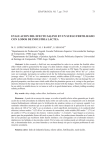
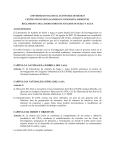
![Fichas Sergo Lubricantes [Carta]](http://vs1.manualzilla.com/store/data/006199649_1-c338c6cf6e00197687c76d58a163e5d3-150x150.png)
![Fichas Sergo Lubricantes [Carta]](http://vs1.manualzilla.com/store/data/006198149_1-54d88f2ab147d0ecc45706893970b5cd-150x150.png)
